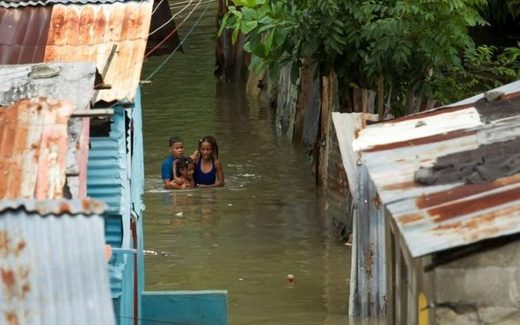
In Europe, where precise data reaches back decades, the number of severe floods has jumped five fold since 1995, according to the report, which updates a 2013 assessment.
"There has been, and continues to be, a significant increase in the frequency of extreme weather events," said Michael Norton, environmental programme director for the European Academies' Science Advisory Council.
"They underline the importance of avoiding greenhouse gases, which are fundamentally responsible for driving these changes," he told AFP.
Comment: And still they continue to push the man-made climate change/global warming lie despite over 31K scientists having signed a petition against the global warming agenda.
For impacts that cannot be avoided, he added, "this makes climate proofing all the more urgent."
In Europe, efforts to shore up defences against river flooding have proven effective: despite an increase in frequency of such events, economic loses on the continent have remained static.
"Rather than just coping with disasters after they strike, we need to shift to proactive management of all drivers of risks," commented Munich Climate Insurance Initiative director Soenke Kreft, who did not contribute to the report.
In the United States, however, the damage wrought by storms doubled, on average, from $10 billion in 1980 to $20 billion in 2015, adjusted for inflation, according to the report, based in part on data from insurance giant Munich Re's NatCatSERVICE.
The update also assessed new findings on possible changes in the Gulf Stream, powerful ocean currents running between the Arctic region and the Caribbean that warm the air in northwestern Europe and the US eastern seaboard.
Climate 'hotspots'
The weakening of the Gulf Stream "is now a credible hypothesis," said Norton.
"Some of the underlying drivers of extreme weather which were speculative four years ago are looking less speculative."
The prospect of the Gulf Stream-also known as the Atlantic Meridional Overturning Circulation (AMOC)-slowing, or even shutting down entirely, "must be taken as a serious possibility," he added.
Scientists have estimated that winters in Britain and much of western Europe would be several degrees Celsius colder under such a scenario.
The study also examined recent disruptions of the polar Jet Stream, a band of west-to-east winds that circulate at bullet-train speed some 10 kilometres above Earth's surface at the upper boundary of the troposphere.
Recent research has linked severe winters in North America and Europe, as well some extreme summer weather, to Jet Stream fluctuations possibly driven by global warming in the Arctic, where temperatures have risen twice as fast as for the planet as a whole.
"The linkage between climate change and individual weather events-such as the 'Beast from the East'-in inherently uncertain," commented Phil Williamson, a climate researcher at the University of East Anglia.
But the new report "is fully consistent with global trends," he added. "For example, there have been roughly ten times more warm record-breaking temperatures than cold one in the last 150 years."
Comment: This is the same University of East Anglia that was linked with the climategate scandal: Climategate: the final nail in the coffin of 'Anthropogenic Global Warming'?
A small selection of related articles on how information has been falsified to support the global warming/climate change narrative include:
- Whistleblower: No more global warming, NOAA scientists falsified temperature data, MSM ignores
- Fake science: Remember how NOAA says each year is 'hottest ever'? Whistleblower sez US govt agency falsifies data to serve global agenda
- 100% of U.S. 'Warming' is due to NOAA data tampering
- Climate science fiction: NOAA avoids atmospheric satellite data which shows no global warming in last two decades
- Record waves, rain and snow across U. S. West Coast but NOAA forecasts drought
- Temperature data faked NOAA, NASA and HadCRU caught red handed
- Global temperature data is almost entirely made up by NOAA
- Global warming fraud: NOAA shows record warming where NO temperature stations exist
A 2016 study in Climatic Change forecast that, by mid-century, pockets of southern Europe will face at least one severe climate hazard every year of the scale now occurring only once every 100 years.
By 2100, according to these predictions, Europe's entire Mediterranean seaboard will be confronted annually with extreme droughts, coastal floods or heatwaves.
And a few "hotspots" will be hit every year by two or more such formerly once-in-hundred-years hazards, which also include wildfires, river floods and windstorms.
Journal reference: Climatic Change



Comment: For more information on extreme weather from around the world, check out our Earth Changes Summaries. The latest video: SOTT Earth Changes Summary - February 2018: Extreme Weather, Planetary Upheaval, Meteor Fireballs
To understand how and why these extreme weather events are occurring read Earth Changes and the Human Cosmic Connection by Pierre Lescaudron and Laura Knight-Jadczyk.